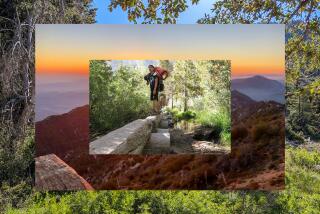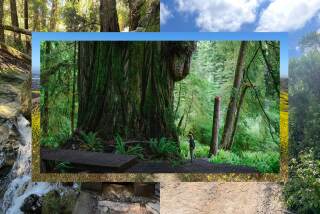Mountain Parks Have Activities Hot Line : Recreation: The service offered by Mountains Conservancy fills in callers on what’s available at 120 sites.
So, Uncle Bud and Aunt Bertie will visit soon from Kenosha, Wis., and you would like to show them the Santa Monica Mountains. But Uncle Bud’s feet sometimes bother him; he would prefer a short, scenic walk on a flat and smooth path. Whom do you call and where do you go?
The Mountains Conservancy Education and Recreation Program in Calabasas offers a toll-free number that links callers with the kind of park they’re seeking within the Santa Monica Mountains National Recreation Area.
“Most people call and say they don’t know how to get to the Santa Monica mountain parks,” said Amy Lethbridge, director of the education and recreation program, which marked its first year of operation in March. “There are about 120 mountain parks to choose from. We work in cooperation with all the park agencies--city, county, state and national--and help take the burden off them.”
Among services offered by the conservancy is the Mountain Parks Information Program. By dialing 1-(800) 533-PARK, callers can learn which parks are nearby, whether barbecues or dogs--among other things--are allowed, or which parks can accommodate Uncle Bud.
First-time callers receive a map of the entire area, which stretches from Griffith Park in Los Angeles to Point Mugu west of Malibu to the Santa Susana Mountains in Simi Valley. Spanish-speaking staff members are also available. Information sent to callers is written in Spanish and/or English.
In Uncle Bud’s case, he will be visiting his sister in Agoura. A parks information specialist types this and other information into a computer and finds out that Paramount Ranch in Agoura--with its historic movie set, views of the Santa Monica Mountains and easy-paced walk--will suit him.
Maria Altobello, a parks information specialist, said the program receives an average of 900 calls a month. Operators are available from 9 a.m. to 5 p.m. weekdays and 10 a.m. to 2 p.m. Saturdays. When the specialists are not in, callers will be asked to leave a detailed message.
Another service provided by the conservancy is the Recreational Transit/Share and Care Program, designed to introduce city-dwelling senior citizens and children to the mountains.
Primarily geared to school-age children, the transit program arranges for buses to pick up inner-city students from schools and churches and take them to parks, where they play games and learn about the outdoors from naturalists.
“This is the decade of the environment,” Lethbridge said. “We hope the kids become motivated enough to improve their neighborhood environments after visiting our parks.
“Sometimes we’ll ask the kids, ‘Who owns this park?’ and they’ll say, ‘God.’ But we tell them they own the parks and invite them to bring their parents back.”
On a recent cool, sunny morning, about 60 students from Oak Street School in Inglewood arrived at Solstice Canyon Park in Malibu.
Naturalist Marlene Padilla asked her party of second- and third-graders what they expected to see on the field trip.
Squirrels, blue jays, a tiger and a koala bear were the answers.
“Well, I bet we’ll see blue jays and squirrels,” Padilla said. “But there’s no tigers and no koalas; there are the trees that koalas eat from, though, eucalyptus trees.”
Later on the trail, Padilla pointed out poison oak with the warning: “Leaves of three, leave ‘em be.”
The group stopped under an oak tree.
“What are these?” Padilla asked, holding round seeds with points on one end and little caps on the other.
“Peanuts?” one boy volunteered.
“No, they’re acorns,” Padilla said, then asked: “Know what the Indians did with them?”
“Played hot potato?” Arturo Nunez asked.
“No,” Padilla said. “They took shells and tar and made them into dice.” She pulled out some authentic-looking acorn dice and invited her team to play.
Lethbridge said the transit program is also funding the training of eight interns, who are co-leading with the program’s naturalists. “Since 90% of the students involved with the Recreational Transit/Share and Care Program are people of color,” Lethbridge said, “we thought it would be great to get someone from their community to interpret for them.”
The interns spent last autumn taking leadership courses through Outward Bound, an outdoor survival program, as well as environmental classes taught by instructors from Santa Monica College.
Lethbridge said students from Ventura and Oxnard will soon participate in the transit program.
“We’re one of the few groups that do what we do,” Lethbridge said of the conservancy’s education and recreation program, funded through a grant from the Santa Monica Mountains Conservancy. “I’m especially proud of our staff. I have the best job I could imagine.”
For information on the Recreational Transit/Share and Care Program, which is booked through July, call (818) 880-0664 and ask for Chris or Rob.
More to Read
Sign up for The Wild
We’ll help you find the best places to hike, bike and run, as well as the perfect silent spots for meditation and yoga.
You may occasionally receive promotional content from the Los Angeles Times.






